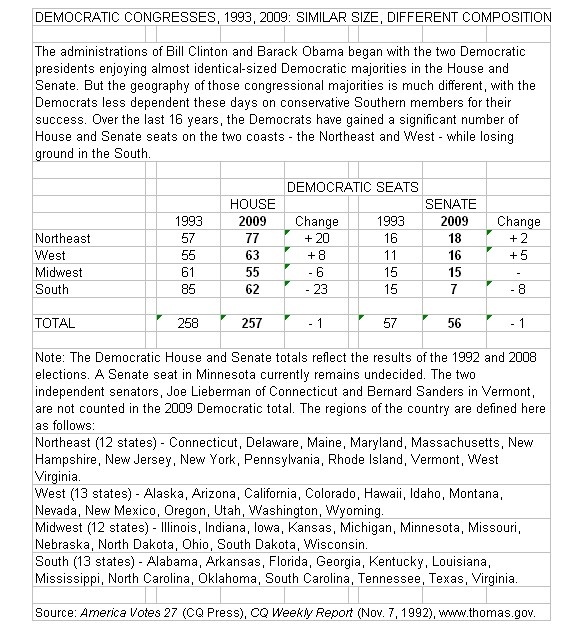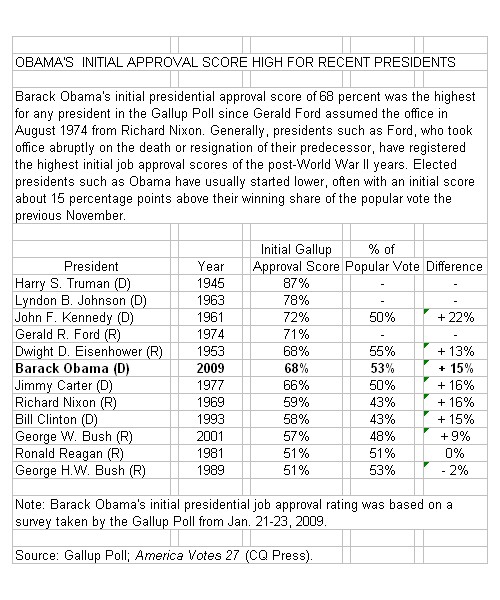Not Your Father's Democratic Congress
A Commentary By Rhodes Cook
The last two Democratic presidents have a lot in common. Like Bill Clinton before him, Barack Obama is a gifted 40-something politician, a strong orator with a high likeability quotient, and a successful candidate who captured the White House by running on a platform offering big change. And like Clinton, Obama begins his administration blessed with large Democratic majorities at the other end of Pennsylvania Avenue.
In fact, the Democratic congressional majorities that Obama enjoys now are virtually identical in size to what Clinton began with 16 years ago. Clinton was accompanied to Washington in 1993 by 258 Democrats in the House and 57 in the Senate. For Obama, last fall's election produced 257 House Democrats and 56 Senate Democrats, a total that inches higher if one counts the two independent senators--Joe Lieberman of Connecticut and Bernard Sanders of Vermont--who caucus with the Democrats. An additional Senate seat could fall to the Democrats once the long-running race in Minnesota is finally settled.
Yet the surface equality masks a major difference between the two Democratic Congresses. The conservative Southern wing of the party was much stronger then than it is now, giving Obama the chance to govern these days with a Democratic majority in Congress that is really a functioning majority.
The regional shift of strength within Democratic congressional ranks over the last decade and a half has been significant. In January 1993, Southern Democrats comprised nearly one third of the party's number in the House and more than one quarter in the Senate. Nowadays, the Southern component of the Democratic majority is less than one quarter in the House and barely 10 percent in the Senate. The Democrats have made up for their Southern losses by gaining congressional seats in the party's more liberal beachheads on the two coasts.
That geographical change has had significant ideological implications. When the conference report on Clinton's budget bill passed the House in the summer of 1993 by the razor-thin vote of 218 to 216, there were 41 Democratic defectors--a majority of which (23) were from the South.
When Obama's economic stimulus bill first passed the House late last month, the vote was a clear cut 244 to 188. The number of Democratic defectors totaled only 11, six from the South. And when the conference report on the stimulus passed late last week, the total number of Democratic defectors was down to seven.
Gone is the talk of a "conservative coalition" of Republicans and Southern Democrats capable of controlling Congress--terminology that was in vogue for much of the second half of the 20th century.
No doubt congressional Republicans stand ready to play their part in the revival of such a coalition. They voted unanimously in the House against Obama's economic stimulus plan and provided only three votes for its passage in the Senate.
That triggered a wave of criticism of the new president's ability to draw bipartisan support on Capitol Hill. Yet such a degree of Republican recalcitrance is nothing new. Throughout Clinton's first year in office, unanimous GOP votes against his economic initiatives were not an unusual sight. On the key House vote on Clinton's budget plan in August 1993, Republicans voted against it, 175-0. In the Senate, GOP opposition to the Clinton plan was also unanimous.
Wrote Congressional Quarterly: "It was the first time in postwar congressional history and possibly the first time ever that the majority party had passed major legislation with absolutely no support from the opposition." And that in an era when there were still a slew of moderate Republicans.
Whether Obama will continue to face a similar dynamic in the 111th Congress remains to be seen. But at least, he has a much more unified Democratic majority to work with than did Clinton 16 years ago. Not only has the conservative Southern element dwindled in size and influence, but Obama appears to start in a stronger position with his Democratic colleagues on Capitol Hill than did Clinton.
As a 43 percent winner in the three-way popular vote for president in 1992, Clinton had virtually no coattails to offer his Democratic congressional ticket-mates and few on Capitol Hill were beholden to him. The Democrats lost roughly 10 seats in the House that year and their number remained unchanged in the Senate.
In contrast, Obama was a solid 53 percent winner in 2008 and helped lead a nationwide Democratic advance that saw the party pick up more than 20 seats in the House plus seven in the Senate (with the outcome of the Minnesota race pending).
In addition, Obama began his presidency with a job approval rating fully 10 percentage points higher than Clinton's at the outset of his term. Very much on the high side for elected presidents, Obama's initial 68 percent approval rating in the Gallup Poll ties Dwight D. Eisenhower's first such score in 1953. And it is only four points below the opening 72 percent approval rating for John F. Kennedy in 1961--the highest for any elected president since World War II.
In short, Clinton never got a honeymoon. Obama has. And he moves forward in his presidency with a Democratic Congress which gives early indication that it will be more compatible with his interests than what Clinton had to work with in the opening rough-and-tumble stage of his administration.
See Other Commentary by Rhodes Cook
See Other Political Commentary
Views expressed in this column are those of the author, not those of Rasmussen Reports.
Rasmussen Reports is a media company specializing in the collection, publication and distribution of public opinion information.
We conduct public opinion polls on a variety of topics to inform our audience on events in the news and other topics of interest. To ensure editorial control and independence, we pay for the polls ourselves and generate revenue through the sale of subscriptions, sponsorships, and advertising. Nightly polling on politics, business and lifestyle topics provides the content to update the Rasmussen Reports web site many times each day. If it's in the news, it's in our polls. Additionally, the data drives a daily update newsletter and various media outlets across the country.
Some information, including the Rasmussen Reports daily Presidential Tracking Poll and commentaries are available for free to the general public. Subscriptions are available for $4.95 a month or 34.95 a year that provide subscribers with exclusive access to more than 20 stories per week on upcoming elections, consumer confidence, and issues that affect us all. For those who are really into the numbers, Platinum Members can review demographic crosstabs and a full history of our data.
To learn more about our methodology, click here.

